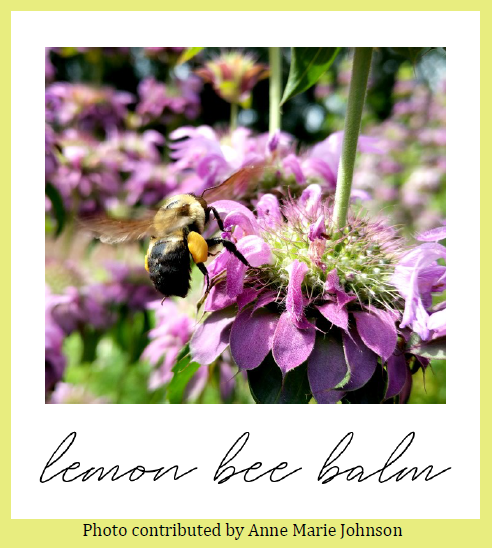
Download .pdf version
As we reach the year’s halfway point, it feels like time is fleeting! Now is the perfect time to get outdoors and stop to smell the…lemon bee balm. During the month of June, the lavender, spiky, and clustered flowers of this native herb begin to flourish and spread throughout both garden spaces and the wild. Also known as Monarda citriodora, lemon bee balm is a member of the mint family, thus it developed the common names of lemon mint and horsemint. The genus Monarda was assigned to all bee balms by 16th century Spanish botanist and physician Nicholas Monardes, and citriodora is Latin for the lemon aroma (literally, “citrus odor”) its crushed leaves deliver.
Bee balm plants have a rich history throughout the eastern United States and southeastern Canada for their medicinal uses. “Bee balm” refers to a popular ointment made with resin of the leaves that can soothe bee stings and is still valued in natural medicines. More commonly, the leaves of bee balm are steeped into an herbal tea, and the product was first referred to as Oswego tea after the Oswego Native Americans in upstate New York. The process was taught to European settlers, and many American revolutionaries switched to Oswego tea in protest to the British tea tax. It is also incorporated into wines and liqueurs, or added to cakes for a light, citrusy flavor. In fact, the entire above-ground plant is edible.
Lemon bee balm makes a great addition to any pollinator garden, as its showy flowers and lemony scent attract bees, hummingbirds, and butterflies. The herb is highly tolerant, and will thrive in even dry and rocky soils. It prefers a sandy soil, which is common throughout Richland County. Though it is an annual, lemon bee balm will readily self-spread throughout the garden area in optimal conditions. In the wild, lemon bee balm flourishes along roads and pastures. Lemon bee balm grows between two and three feet in height and its lemony aroma is most noticeable when the plant is massed.
While it prefers a sunny location, lemon beebalm tolerates shade especially during the hot summer. In order to increase flower production, pick the flowers and make sure to deadhead as the blooming season progresses . Deadheading is the removal of flowers once they shed their petals and start to form seed heads. The energy in the flower shifts to the development of seeds rather than flowers, and the flowers can lose their attraction. By cutting dead flower heads, one can enrich the blooms and lengthen the bloom time . As long as the flower is kept somewhat moist, it should not be susceptible to foliar diseases. Powdery mildew is a white fungus that is common amongst Monardas, but it only affects their appearances, not the overall health of the plant. A solution is to water the roots instead of the foliage, and be sure to plant the herb in a spot that gets plenty of sun to dry up excess water.
Pollinators love lemon bee balm, and it is a native and attractive addition to a pollinator habitat. Show pollinators they are appreciated, especially during National Pollinator Week (June 22nd-June 28th), by planting some lemon bee balm for them (and you!) to enjoy.
References: Preserving Pollinators, Clemson Extension, the University of West Alabama, the University of Missouri, the United States Department of Agriculture
Download .pdf version
# # #
Conservation Districts are political subdivisions of state government under the local direction of five-member Boards of Commissioners. In South Carolina, Conservation District boundaries conform to County boundaries. The Richland Soil and Water Conservation District promotes the wise use and care of natural resources for long-term sustainability.
Contact
Richland Soil and Water Conservation District
2020 Hampton Street, Room 3063A
Columbia, SC 29204
Phone (803) 576-2080
Fax (803) 576-2088
E-mail soilandwater@rcgov.us
Facebook www.facebook.com/rswcd